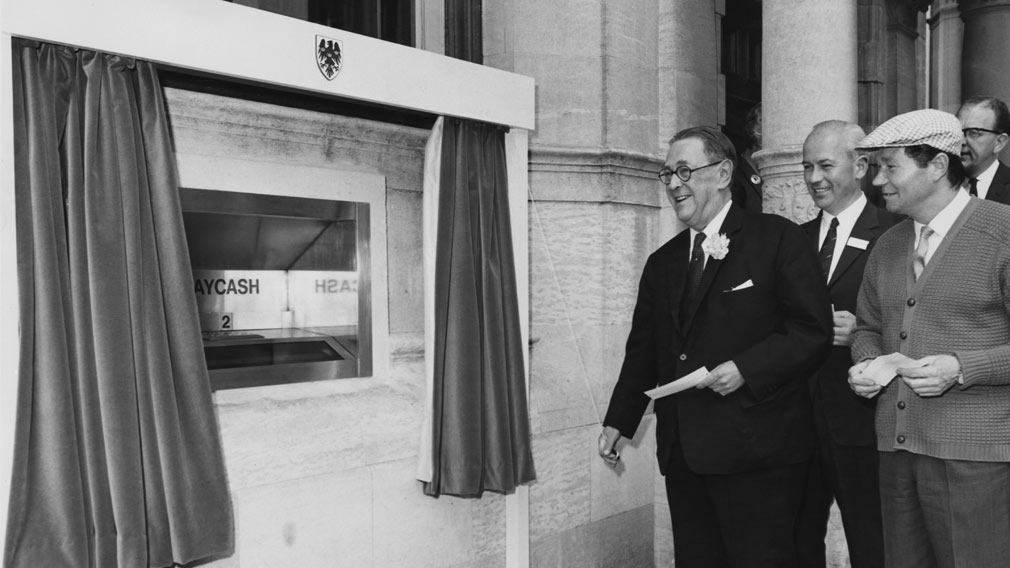ATM fee cull as ‘always on’ culture rolls on

Sir Thomas Bland, Deputy Chairman of Barclays Bank, unveils the first Barclaycash machine in London, 1967 (Getty Images).
Looking ahead, the banks’ move to axe ATM fees for non-customers in some ways epitomises one technology eating away at another, a trend increasingly gathering pace.
Sure, the decision comes as banks are also seeking to better serve customers and meet higher community standards in a difficult environment for the industry.
But as several analysts noted, the banks’ revenue generated from “foreign” ATM fees – those charged to non-customers – has been sliding as cash usage declined in recent years amid a surge in payments via new technologies, highlighting how the humble 50-year old ATM machine is these days very much an “old” technology in the fast moving space.
As a global CEO survey by PwC last year revealed, the “speed of technological change” was one of the biggest concerns, a view held by 70 per cent of financial services leaders.
“One factor is that the time it takes to go from breakthrough technology to mass-market application is collapsing. For example, in the United States, it took the telephone 76 years to be adopted by half the population. By contrast, the smartphone did it in under ten years. We are now watching blockchain move from a notebook sketch to an established technology in a tiny fraction of the time it took for the internet to be accepted as a standard tool.
“Indeed, technology-driven change is so pervasive that no financial institution is immune.”
Although the topic of some debate over the years, the first iteration of the ATM emerged in 1967 at Barclays in London. While a wave on new technologies have popped up since, the ATM is often heralded as one of the industry’s great innovation triumphs for customers. Indeed, James Shepherd-Barron, the son of inventor John Shepherd Barron, in June wrote in the Financial Times that the ATM was “one of the greatest financial inventions in recent history”.
“When the ATM came along in 1967, consumers experienced not just an encounter with a new technology, but an entirely new way of relating to machines. Initially sceptical of having to push buttons and remember personal identification numbers, the machine’s no-nonsense exterior and intuitive user interface eventually won people over. The ATM blazed a trail towards today’s 24/7 ‘always-on’ culture,” he wrote.
These days, the internet – and more recently mobile phones – have taken the baton and supercharged the so-called ‘always-on’ culture for banks, and the rate of technological change to the point where smartphone apps become dated within months.
According to The Reserve Bank’s recent How Australian’s Pay Survey, credit and debit cards combined were the most frequently used payment methods last year, overtaking cash for the first time as consumers increasingly shop online and adopt near field technology that allows people to “tap” when paying. Consumers’ payments in cash slipped to 37 per cent by number from 69 per cent in 2007. For the first time in the RBA’s triennial Consumer Payments Survey’s history, the majority of respondents (55 per cent) did not top-up their cash holdings during the week last year. “Contactless ‘tap and go’ cards are an increasingly popular way of making payments, displacing cash for many lower-value transactions,” the RBA said.
While banks’ overall ATM income aren’t disclosed, Deutsche Bank analyst Anthony Hoo estimates the big four banks generated between $22m-$38m in gross revenue each from foreign ATM transactions, which when removed will reduce earnings roughly 0.2-0.3 per cent a year.
“We note that the usage of ATMs has been declining over the past few years. The number of foreign ATM withdrawal transactions has also been falling – on a 12-month rolling basis the total of 252m transactions in July 2017 was 5 per cent lower than a year ago,” Hoo told clients.
“From a system perspective, this has been driven by increasing use of cashless forms of payments. Hence for the banks, this source of revenue from ATMs was likely to be a declining contributor already.”
Hoo went on to predict that the reduction in fees raised other issues around the future of ATM networks beyond the immediate benefit for consumers of fewer fees, including whether operators would maintain the same level of investment and maintenance in their networks given the costs.
Other analysts made similar predictions, albeit CLSA’s Brian Johnson said ATMs were still an “important branding/deposit gathering mechanism”.
The history of the foreign ATM fee in Australia dates back to 2009 when reforms to pricing arrangements allowed providers to set their own “direct charges” for transactions for the first time to replace what the RBA dubbed “highly inflexible and opaque interchange fee arrangements”. The reforms spurred a rise in ATM numbers, including from providers other than banks, which have some of the largest networks. But usage has been declining.
Stargroup, a listed ATM company, experienced a swift response to the uncertainty on Monday when its shares dived 25 per cent following the decision by Commonwealth Bank, ANZ, Westpac and National Australia Bank to remove foreign ATM fees.
George Frazis, Westpac’s group executive of consumer banking, said the withdrawal of the “deeply unpopular” ATM fees at the group’s 2925 machines was a “logical extension” of the benefits Westpac, St.George, Bank of Melbourne and BankSA customers had enjoyed across the various branded ATMs.
He also noted that there was a cost associated with ATMs, but Westpac was “listening and responding to consumer concerns”, similar to other recent initiatives such as removing teller sales incentives.


